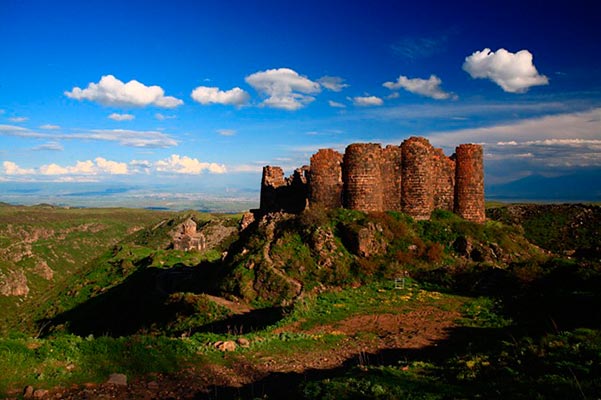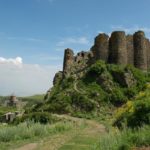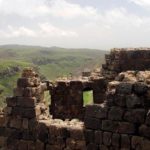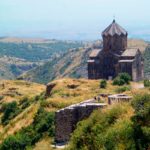Armenia is famous not only for its monasteries and churches, but also the amazing fortifications. This is not surprising – the history of this country is not the most peaceful, and the people of the local land often had to defend their possessions against vastly superior forces of the enemy, which is a special charity did not differ, and in case of a fall protection facilities would not spare anyone. That is why the Armenian builders of old were famous for their skill in the construction of castles and forts, extremely reasonably furnished for those times, using unique technologies. Such objects is still popular with travelers and are included in the program of tours in Armenia .
An example of such a masterpiece of Armenian architecture can be called Amberd fortress. Powerful fangs, built of massive blocks of walls and towers, and now it rises on the southern slopes of the sacred mountain Aragats. To get here, the enemy had to work hard at first even to climb to a height of twenty-three hundred meters. Fortress looks glumly at the Ararat valley. A lot of pride it gives is that once these halls raised cups princes Pahlavani, which were the proud owners of the land for three centuries, from the tenth to the thirteenth century. The tour operators of Armenia are advised to familiarize themselves with the history of the fortress in front of her visit, then the journey will even more fun.
Such fortifications on the territory of Armenia were not enough. For many centuries, the land was required to defend against raids by the Romans, Byzantines, Persians, Seljuks, Mongols and Turks, who always wanted to seize the wealth and fertility of the edges. To make generic nest inaccessible, local rulers tried first to take advantage of the power of his native land. For the construction they chose sites located as high as possible in the mountains, preferring steep cliffs, surrounded on all sides by rough waters of mountain rivers. Pond next to necessarily needed, he served not only as a natural protection, but also the source of life for the people in the besieged fortress. And because the citadel necessarily led up water from nearby rivers or located upslope sources using water supply systems. Such wonderful things you’re unlikely to see while relaxing in Uzbekistan.
Amberd Fortress built precisely on the basis of these vital laws. Castle laid on a promontory that both sides embrace dramatic cliffs gorges. The wall covers it, and at the foot of the manor house were modest houses cling servants. Most likely, all the buildings have been erected on the foundations of older buildings that were used for the same purpose, and were built as early as the seventh century.
To the enemies were not able to penetrate the fort wall made natural continuation of the slopes of the gorge, and they are composed of powerful basalt boulders, siege structures could not penetrate the thick of so easily. And over the castle, up the slope it was undeveloped dam, which is part of the flow, especially after the rapid melting of snow on the ice cap summit, to cross into the fortress to the water reserves are never failed.
Amberd main task was to protect its rulers from enemy attacks, and therefore about any external beauty of construction, however. No, magnificent castle, but the special beauty, which is famous for its extremely reasonable and functionally adapted structure, perfectly fulfills its mission. No architectural excesses, all intended to make so that the wall stood against any siege. From decorations only, earthenware plates, soldered to the brickwork under the teeth. And it is not for the charm of tradition the fort, and to ward off the evil eye. In those days believed that some forces will not be saved, and massive walls. Lock externally protected powerful tower, inside the space divided into two parts. The one that was closer to the wall of the fortress intended for the soldiers defending the castle. In the long settled household and living quarters on the ground floor, as well as the state rooms on the upper. In total, the castle was three stories, but the top over time have been destroyed, but because to say anything clear about their planning difficult. The door leading from the castle up the hill to the houses inhabited by peasants, not just locked, and closes the heavy stone slab, which held strong wooden beams. The windows, which in the structure was not so much defended thick iron bars. The top of the wall was cut by narrow loopholes through which the heads of the attackers were strewed boulders, missiles, and even something hot.
However, the citadel could be surprisingly hospitable place, if a guest came here in peace. Armenian rulers appreciated and comfort in life, even if threatened from all sides by enemies. These qualities are still famous and hotels in Armenia , the benefit that the hordes of enemies they now do not get any. In the inner chambers, cold stone walls were lavishly draped with fluffy soft carpets, gladdening the eye bizarre patterns. Comfortable furniture covered with soft tissue. Thirst was always possible to satisfy, sipping water from a clean source, which is located on the first floor, where clay pipes dripping moisture from the mountain springs. Although it was much better to try something from the cellars of the hospitable host, filling the exquisite Armenian bowl, or elegant glasses made of Egyptian glass, fragrant wine Ashtarak. And when the sunset delicate crimson stain the slopes of Mount Ararat, lilac and mauve flashes of glare reflecting on the snow peaks, then the walls will play warm lights of the light incident from bronze lamps, gentle sounds of music fill the chambers, and the warm air tremble and dissipate the sweet smell of tar melting in Censer.
This alluring picture helped recreate archaeological excavations that were able to discover the castle and the remains of bronze lamps, and incense, and fragments of dishes and thin-walled painted vials and even mortars for the preparation of aromatic compounds.
Another surprising finding was a medieval bath, is remarkably well preserved. Armenian princes were not alien to the joys of bathing, but prefer to do it in a much more comfortable than the offered Russian pair, for example. Here, not only washed, but also pleasantly spent time, we were friendly conversations and just enjoying life. These indispensable attributes of luxurious existence of the Armenian nobility repeatedly mentioned in medieval literature. However, a clear picture of how they are equipped, it has given this finding.
Inside the building you can find two rooms with no windows, sanctified only by glass lampshades, located on the ceiling. Inside the room it was completely lined with stone, which does not seem very reasonable at high altitudes. But with the help of a special system of heating, steam acted not only in itself a steam room, and conducted through pipes under the floor and in the walls, which made all the inner surfaces of the warm room.
In the second room was located a small pool, which led two pipes – with hot and cold water. These pipes were made not from clay, and metal, and were joined by some devices that resemble modern clutch. And found here seems to have the water flow can be shut by a bronze bushings.
There was a bath and a wooden outbuilding in which dwelt her manager – attendant. His concern was to follow the heated reasonably adjusting it at the request of owners, as well as to produce various ointments for special recipes, based on aromatic herbs and aromatic oils, and create a variety of censers mixture. At least, it is the place of this construction, archaeologists have found a mortar and bronze incense burners and ceramic bottles and bowls, which can be stored spiced ointments.
The very history of the fortress was sad, in spite of the strong fortifications and all reasonable action taken by the owners, it still fell in the thirteenth century under the pressure of the Mongol troops. More in this citadel no one lived, the ruins were not restored, and a quiet haze of fog, harboring the mountain slopes, and the sounds of babbling river, waited for people to come back here.
Archaeologists were able to find here a lot of valuable exhibits, including evidence that the rulers gladly bought and used the products overseas. In the ruins shards heavy matte dark green porcelain were found in distant China, and expensive painted glass from Egypt.
Not far from the fortress you can find a charming building Vahramashen church, which was built in the eleventh century. The very small building, but it looks amazingly picturesque hilltop overlooking the deep gorge. Mixing of blocks of different colors of sand to dark gray, harmoniously enter the temple in the surrounding harsh landscape. Church suffered the same fate as the castle, it burned the Mongols, who took the castle. However, she remained better than the remnants of the citadel. To visit this place, it is not necessary to plan a long trip, the castle is located near Yerevan, and you can go here for half a day directly from the Hotel Armenia , which you have chosen in the capital.












